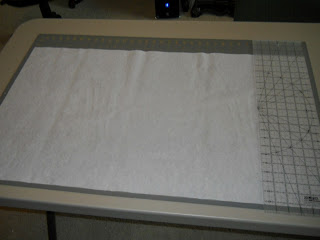Have you ever seen a piece of fabric that just called to you? I certainly have, and the fabric pictured below was one of those. One of the ladies in my sewing class suggested a tote bag as one of our projects, and I just had to use this fabric, even though most of my girls wanted to lay claim to it when they saw it. I can't blame them - it's so pretty. I got the general idea for this bag from a book I have, but I changed the size, the straps, and I added a pocket.
You'll need outer and lining fabric, and braided belting. 1 & 1/3 yard of each fabric, and 6 yards of belting will make two bags. 2-4yd of interfacing may be needed, depending on your fabric choice.
You can use cotton fabric, but both the outside and the lining will need to be lined with fusible interfacing to give the bag strength, or you could use a lightweight duck instead. For the bag I'm showing, I used duck for the outside and cotton, lined with fusible interfacing, for the lining.
If you need it, clicking on the pictures will make them larger.
For solids, or an all-over print, cut a piece that is 32"x21" for the outside of your bag.
My fabric was a one way print so I cut two, 16.5"x21" pieces.
I placed them, right sides together, and stitched using a 1/2" seam.
Then, since duck frays pretty easily, I overcast the edges.
After that, I pressed the seam to the side and top-stitched it in place.
Next, cut the lining fabric 35"x21".
The fusible interfacing was about 20 1/2" wide, so I only had to cut for length.
I cut it a little less than 35" so the lining fabric would overhang by just a little. It's just easier to do that than to try and line everything up exactly when you're ironing them together.
Go ahead and attach the interfacing to the wrong side of your lining fabric.
Now cut the fabric for the pocket.
One 10 1/2"x8" piece for the outside, and one 12"x8" piece for the lining.
Cut a 12"x8" (or slightly smaller) piece of interfacing too, and attach that to the lining.
If you have a one way print, make sure the 10 1/2" length goes with the grain/pattern.
With right sides together, sew the top edges of the pocket and lining together.
Press the seam flat.
Then fold it so the bottom edges meet. You'll have a strip of the lining showing at the top.
Press, and then overcast around the three raw edges. You can use an overcast stitch (if your machine has one), or a wide zig-zag. I ironed a piece of fusible web along the bottom, between the outside and the lining to help keep it from shifting while I was sewing, but you don't have to do that.
Fold your bag in half (with the 21" sides together) and press so you'll have a line that will be the bottom of the bag. I didn't have to do that because there was a seam right down the middle of this one. Then, at the bottom, mark the center of the bag and the center of the pocket and line them up, right sides together. You'll want to make sure the bottom edge of the pocket overhangs the bottom line of the bag by 1/2". Pin in place and then stitch 1/2" from the bottom of the pocket. Your stitch line should line up with the crease you made in bottom of the bag.
If you have a one way print and are constructing the bag like this one, you can assemble the pocket first and then sew it in when you're sewing the front and back of the bag together, but since a lot of duck isn't a one way print, I wanted to show how you'd do it if there wasn't a seam.
Press the pocket up, pin in place, and then stitch around the sides and bottom, 1/4" from the edge of the pocket. Don't worry about the raw edges - the straps will cover it.
Now you'll add your straps. You'll need about 3 yards of braided belting.
Starting at the bottom crease/seam, pin the strap in place. You'll measure 6" from the sides of the bag, and then lay the strap down.
When you get close to the top edge, place your last pin 1" from the top. You will not sew past this pin. You need the last bit of the top free from the strap so you can sew in the lining.
Let the strap loop about 24" from the last pin to the first pin on the other side. Continue to pin the strap in place down the front of the bag and then keep going onto the back side, remembering to stop pinning an inch from the top of the back, make a second 24" loop, pin again 1" from the top and meet the starting point. You may need to trim the belting just bit. If this confuses you, just take another look at the picture above this one. The belting forms a continuous loop around the bag, forming the straps at the top edges of both sides.
Stitch down both sides of each of the straps. Just slide the pins over a bit during your first pass, but leave them in to keep the belting from shifting as you go.
You'll want to stitch over the point where the two raw edges meet. Use a wide zig-zag, but set your stitch length short so that you're basically forming a satin stitch.
Next we'll fold the bag so that the right sides are together, and stitch down the sides.
Repeat for the lining, and don't forget to overcast the edges. You can use a wide zig-zag for the overcast.
Now we'll square the corners.
Fold the side seam down so that it lines up with the bottom seam. This brings the corner to a triangle. Measure 1 inch from the point of the corner and sew across. Do this for each side of both the bag and the lining.
Leave the lining inside out, but turn the bag right side out. Place the bag in the lining (the right side of the lining will be against the right side of the bag) and pin around the top edge. You'll want to leave a section open for turning later. I left the area between the straps on the back of the bag open. This area is marked by the red pins that are pinned in perpendicular to the edge. Pinning it this way helps you know where to stop and start your stitching so you don't accidentally sew it all closed. You also need to make sure the straps are down out of the way so they don't get caught in the stitching.
Reach in your opening and start pulling it right side out.
When everything's turned, take a second to reach in and finger press your squared corners to the bottom.
Push the lining down into the bag, fitting it to the bottom. About 1 inch of your lining should show above the top of the bag. Press and then top-stitch around the top of the bag.
In this photo the strap is pulled down out of the way, but as it got close to the presser foot, I pulled it up so the top-stitching ran right across. I even backed up so the stitching was re-enforced across the strap.
As you can see here, the top-stitching is very close to the seam.
All finished.
The pocket was a little on the small side, but this was a trial run. I want the pocket deeper in the future, so the dimensions I gave above will make a pocket that is a couple of inches deeper.
I hope the instructions are clear. Happy Sewing!!
I've linked this post with the Homestead Barn Hop.

































Tote bags are so much fun and so functional!
ReplyDeleteYes they are, and I love large totes.
Delete